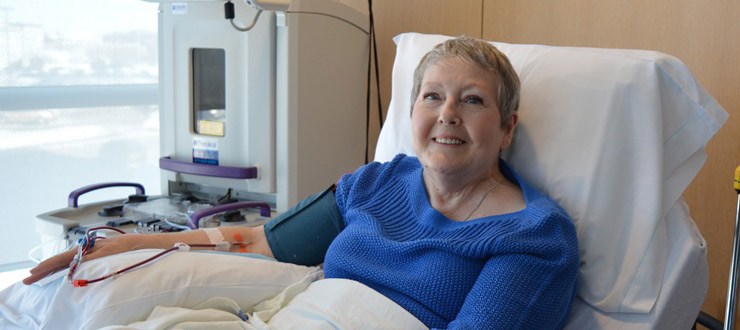
Dorothy Caroll no longer has to travel to Toronto for treatment, thanks to new technology provided through a partnership between The Ottawa Hospital, the Champlain LHIN and Cancer Care Ontario.
After Dorothy Caroll received a bone marrow transplant to treat Chronic Lymphocytic Leukemia, a type of cancer that starts in white blood cells, she developed a common secondary condition called Graft Versus Host Disease.
This severe and disabling condition leads to many complications, including damage to vital organs and skin ulcers that don’t heal. High-dose steroids are the first-line treatment, but close to half of patients require additional treatments, such as photopheresis – a weekly treatment that alters white blood cells.
Until recently, Toronto was the closest place to receive photopheresis. Although some made the costly and tiring trips, other patients in the Champlain LHIN could not go because of the medical, financial and emotional burdens associated with frequent and extended travel to Toronto.
However, patients such as Caroll can now receive photopheresis treatment at The Ottawa Hospital, thanks to a partnership between the hospital, the Champlain LHIN and Cancer Care Ontario.
“I am thrilled beyond measure to have this treatment available to patients in Ottawa,” said Caroll. “I travelled to Toronto for two-and-a-half years for treatment. The travelling was not only physically taxing, but also financially challenging.”
“We now have a state-of-the-art therapy for one of the main complications of transplants that decreases patients’ quality of life,” said Dr. Christopher Bredeson, Head of Malignant Hematology and Stem Cell Transplantation at The Ottawa Hospital. He played an important role in bringing this treatment to Ottawa. “If the leg ulcers are gone, if there is no need to place dressings on the legs three times a week, that’s much better. If the patient’s mobility improves and they can live more independently, then this is a homerun.”
The Champlain LHIN provided about $80,000 to purchase the photopheresis machine. Cancer Care Ontario is funding most of the operational costs and the remainder is paid for by The Ottawa Hospital.
Photopheresis therapy withdraws blood from the body over three to four hours and separates the white blood cells from the red blood cells and plasma, which are immediately returned to the patient. The white blood cells are treated to make the immune system more ‘tolerant’ and reduce symptoms of immune rejection.
Caroll said her health has greatly improved since she started receiving her treatments in Ottawa. “It makes such a difference in my life. Needless to say, that I had depressive moments. I was in tears more than I smiled. I did get better.”
Excerpted and reprinted with permission from the Champlain LHIN.

Support patient care and research at
The Ottawa Hospital


 To reset, hold the Ctrl key, then press 0.
To reset, hold the Ctrl key, then press 0.